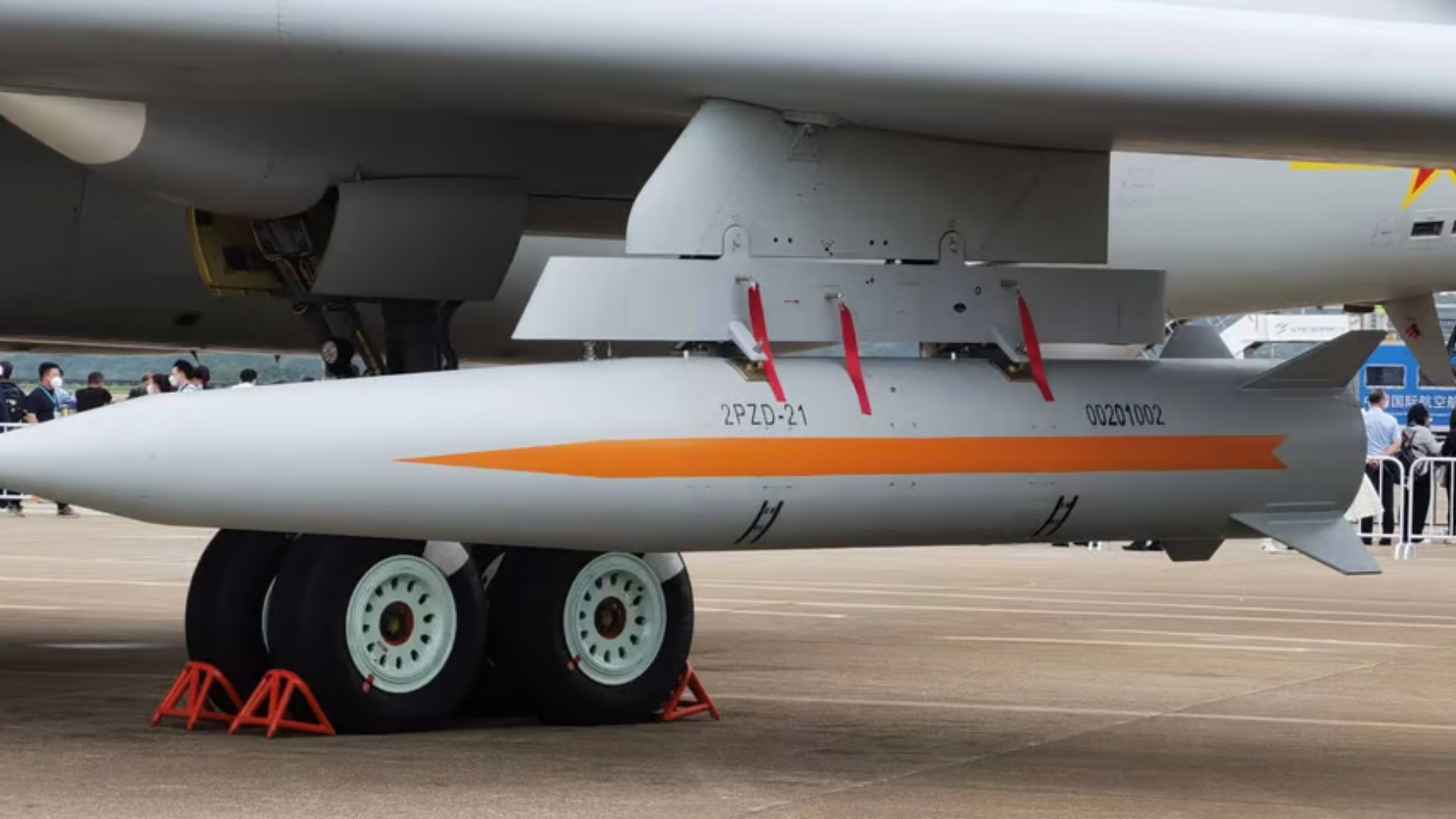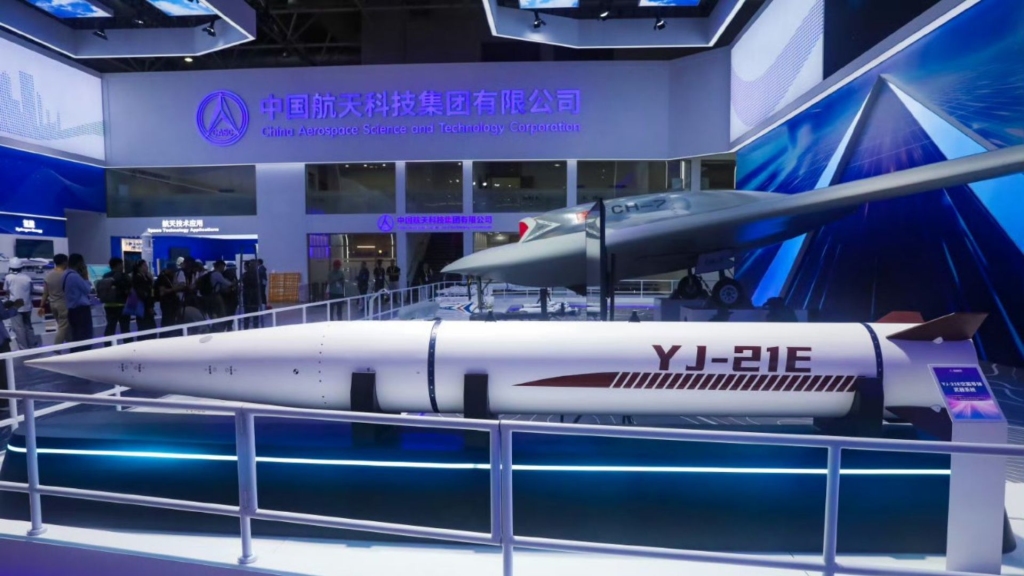8366Views

YJ-21 Hypersonic Anti-Ship Ballistic Missile
The YJ-21 – also known as the Eagle Strike 21 – is a new hypersonic anti-ship ballistic missile (ASBM) designed for striking large, high-value naval targets, such as aircraft carriers. Other probable designations of the YJ-21 are 2PZD-21 and KD-21.
The YJ-21 was first officially shown in April 2022, when a People’s Liberation Army Navy (PLAN) Ruhai-class (Type 055) destroyer test-fired a missile via a vertical launch system (VLS) tube.
YJ-21 Missile Design
The YJ-21 may be a derivative of the land-based DF-21D ASBM, which became operational in 2010. The DF-21D was China’s first dedicated ASBM, designed specifically to target large moving ships, notably aircraft carriers.
The Chinese leverage ASBM technology as a key tool in their wider anti-access and area-denial (A2/AD) strategy, an organized effort to keep enemy naval forces – such as American carrier strike groups – away from Chinese shores and areas of interest.
By introducing a hypersonic ASBM into the mix, the PLAN is aiming to use a combination of high-speed and terminal-stage maneuvering as a means to overcome otherwise robust naval air defence systems, such as the U.S. Navy’s Standard Missile (SM)-series system.
The YJ-21 fits alongside a broader ecosystem of assets – including both nuclear-powered and conventional submarines, fighter aircraft, surface warships, satellites, and others – in the PLAN.
YJ-21 Specifications and Capabilities
The successful launch of the YJ-21 hypersonic missile from a Type 055 destroyer significantly enhances China’s naval capabilities, posing a serious challenge to the US’s ability to defend Taiwan against potential Chinese unification efforts.https://t.co/VXqawdCcqk
— William Huo (@wmhuo168) August 10, 2024
To-date, little is publicly known about the YJ-21’s specifications or its capabilities. Based on the information available from various analysts, the following attributes could be expected:
- Speed: The YJ-21 is capable of hypersonic speed, exceeding Mach 5 and, according to official Chinese publications, reaching Mach 10.
- Range: The YJ-21 may have a range of 1,200 km to 1,500 km, giving the PLAN significant reach, especially when it deploys the ASBM from ships and aircraft, like the Type 055 and H-6N, respectively.
- Warhead: The YJ-21 is likely equipped with a high-explosive warhead; it is unclear if it can optionally carry a nuclear warhead.
- Guidance: The YJ-21 likely uses an inertial navigation system (INS) as well as an active radar-homing or infrared terminal-state seeker.
- Length: 7 to 9 meters.
- Diameter: 0.76 to 0.85 meters.
- Weight: Approximately 2,000 kg.
- Platforms: Besides the Type 055 destroyer, the YJ-21 may also be compatible for launch from aircraft, such as the H-6N bomber.
Some analysts infer that the YJ-21 could be based on the CM-401, an earlier ASBM deployed by the PLAN. However, while there are several outward or aesthetic similarities, the YJ-21 could be distinct, especially as it likely leverages newer technologies.
There are several outward or aesthetic similarities between the YJ-21 and the CM-401, an earlier ASBM deployed by the PLAN. But analysts caution that the similarities may be coincidental.
Overall, the YJ-21 is compact enough to fit in a VLS cell, potentially the HT-1E Universal VLS equipping the PLAN’s new ships, such as the Type 055 and Type 054B. The HT-1E can carry both long-range surface-to-air missiles (SAM) and surface-to-surface missiles (SSM), like the YJ-21.
It is unclear how the PLAN will leverage the added flexibility from the HT-1E. However, the YJ-21 clearly indicates the PLAN’s goal to start working beyond just island-based launch platforms. Rather, the PLAN wants to flexibly carry ASBMs with its surface task forces and, in turn, show that its most impactful anti-ship weapons can follow adversaries’ movements at sea (i.e., they’re not restricted to specific islands).
Potential Export Version

During the 2024 Zhuhai Airshow, the China Aerospace Science and Technology Corporation (CASC) showcased a mock-up of the ASBM with the designation, “YJ-21E.”
This may be a sign that China is preparing the YJ-21 for export, but further confirmation is needed. When exporting missiles and drones, Beijing voluntarily follows MTCR rules by restricting the ranges of its weapons to under 300 km.
Analysis: Why China May Export the YJ-21(E)
In terms of marketability, the YJ-21E would make China the leading supplier of strategically impactful weapons. Beijing already markets numerous subsonic and supersonic-cruising missiles as well as air, land, and sea-based ballistic missiles. The YJ-21E would basically augment a comprehensive product roster.
This product portfolio attracts many countries, especially Pakistan as well as the Arab Gulf, Middle East, and North African governments. In fact, historically committed users of Western equipment, like Qatar and Saudi Arabia, are also growing customers of Chinese ballistic missiles.
From a global security standpoint, hypersonic ASBMs could make their way into several sensitive regions.
For the United States, the threat of the YJ-21 may not be limited to the South China Sea; it may become a factor in the Persian Gulf, Arabian Sea, Gulf of Eden, and many other regions.
In a sense, the proliferation of advanced Chinese weaponry, from the YJ-21E to the HD-1A to the J-35A and so on, could stretch American security resources by creating more complex environments outside of the Pacific Ocean. American security planners will have to account for the existence of drones, supersonic and/or hypersonic missiles, or possibly stealth fighters in other parts of the world.
Managing or containing the potential fallout of such capabilities could require more U.S. assets to be stationed or allocated in those other regions. Proliferation could stretch American resources thinly, which can prevent Washington from fully focusing on its Asia-Pacific plans.
